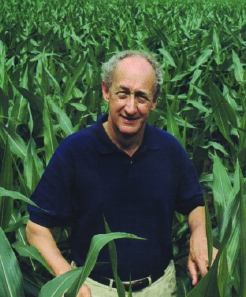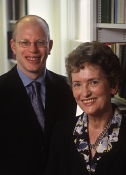Bolstering the research enterprise opens the door to new strengths.
Renowned in academic circles for its distinguished programs in the humanities, as well as its highly ranked professional schools, the University is one of the nation�s leaders in higher education. But to be a truly great institution, the University must establish equivalent strengths in the sciences and engineering. Developing strategies for achieving this goal was one of the purposes of the Virginia 2020 planning process.
In the fall of 2003, the Board of Visitors moved boldly to fulfill this vision. The board agreed to spend $60 million over five years to enhance the University�s programs in scientific, biomedical, and engineering research.To be combined with state bond funds for a new medical research facility and grant revenues generated by our investigators, the board�s commitment is part of a $126 million effort to raise the stature of the research enterprise.
The University will invest these funds in ways that yield the best returns. We will dramatically increase our laboratory space, we will provide compensation packages and other incentives to retain our best faculty, and we will recruit at least ten stellar research teams that can capitalize on the University�s existing strengths across a number of disciplines.
Special attention will be paid to scientists and engineers working in the areas of morphogenesis and regenerative medicine, in quantum and nanoscale studies, in computer and information sciences and engineering, in regional environmental studies, and in aging. These areas emerged in the Virginia 2020 planning process as showing exceptional promise for achieving groundbreaking results with additional support.
CAPTURING OUR CURRENT MOMENTUM
The board�s action reflects the understanding that the University must do its part to advance the scientific and technological discoveries that define our times. Attracting nearly $296 million in grants for sponsored research this past year, the University already has made substantial headway in achieving these ends by making key faculty hires and by fostering the collaborative, cross-disciplinary culture that will be critical to generating new breakthroughs.

Brown-Forman Professor
of Psychology, leads the new
Institute on Aging.
An example of early progress is the new Institute on Aging, where multidisciplinary research now under way will help address the needs of the elderly, as well as the challenges posed by the baby boom generation as it nears retirement age. Directed by Timothy Salthouse, the Brown-Forman Professor of Psychology and one of the world�s leading authorities on the ways aging affects memory and other mental processes, the institute has used funding from the Office of the Vice President for Research and Graduate Studies to launch six pilot projects. Neuroscientist Bernard Maier, for example, is looking at how genes can be manipulated to reverse the cellular effects of aging. John Lach in electrical and computer engineering is developing a wearable health monitoring device, and Carol Manning in neurology is studying the relationship between cognitive impairment and the levels of certain brain chemicals. More on the institute can be found at www.virginia. edu/aginginstitute/.
Age-related research is taking place in schools and programs across the Grounds, including the Department of Health Evaluation Sciences. Robert Abbott, a professor of biostatistics in the department, is co-author of a new study published in the Journal of the American Medical Association showing that sedentary elderly men are nearly twice more likely to develop dementia than those who walk two miles a day. The link between walking and cognitive ability is not clear, according to Prof. Abbott, but it may be related to the healthier lifestyles followed by those who exercise regularly.
Working with novel nanoscale structures, a cross-disciplinary team of physicists and materials scientists has taken yet another step toward the production of amorphous steel, a revolutionary new material that could be used in everything from submarines to tennis rackets. After nearly two decades of research, Joseph Poon, the William Barton Rogers Professor of Physics; Gary Shiflet, the William G. Reynolds Professor of Materials Science; and materials physicist Vijayabarathi Ponnambalam succeeded in producing a nonmagnetic steel that is three times stronger than conventional steel and that can be machined and molded like plastic.Called amorphous steel because the material consists of a randomized arrangement of atoms rather than a crystal structure, the material holds great promise for industrial and military uses.
In the area of regional environmental studies, University students and faculty are looking at how the social, economic, and political dimensions of human activity affect the climate and other environmental factors over large stretches of the planet. In southern Africa, for example, Bob Swap (College �87, Graduate Arts and Sciences �90, �96) of the Department of Environmental Sciences has studied the way clouds of aerosol particles produced by massive annual fires, sparked by both human and natural forces, make an impact on climate patterns in the region. In his effort to understand what he calls "the complex feedback loop" between humans and the environment, he has been the catalyst for collaborative educational, research, and outreach programs that involve colleagues across the Grounds. He works with faculty in the schools of Nursing and Medicine and the Department of Anthropology, for example, to explore the link between the environment and human health issues in the developing world.

environmental sciences, is helping
to lead international efforts to
address the effects of reactive
nitrogen.
James Galloway, also a member of the environmental sciences faculty, has been a leader in establishing the International Nitrogen Initiative, a coordinated effort supported by the United Nations and other agencies to minimize the harmful consequences of nitrogen in the environment while augmenting its beneficial effects. From unprecedented ozone levels in the air we breathe to algae blooms in our waterways to the acidification of our streams, a multitude of ills can be traced to the reactive nitrogen we introduce when we fertilize crops or burn fossil fuels. At the same time, much of humanity relies on the food produced with this substance, and portions of Africa suffer low crop yields and malnutrition due to a deficiency of nitrogen in the soil. Prof. Galloway believes our future depends on a fuller understanding of how nitrogen cycles through the environment, on both global and local scales, and how we can manage its use more wisely.

Nisha Botchwey Fostering a Diverse Faculty Edward Botchwey in the Department of Biomedical Engineering and Nisha Botchwey in the Department of Urban and Environmental Planning were among eight 2003�2004 fellows in the Excellence in Diversity program, created by the Office of the Vice President and Provost and the Dean of Arts and Sciences to nurture the careers of minority scholars. An expert on tissue engineering, Mr. Botchwey studies the promise of bone repair using bioreactor technology. Ms. Botchwey specializes in community development and how local religious and secular institutions can promote public health. |
William Ruddiman, professor emeritus of environmental sciences, drew international headlines this past year with research showing that humans have been causing global warming not just since the dawn of the Industrial Age but since the dawn of widespread agriculture. According to Prof. Ruddiman, civilization has flourished because the climate for the past 8,000 years has been relatively stable and moderate. This, he explains, did not occur naturally, but happened because humans cleared enormous tracts of forest in Europe, China, and India to make room for crops and pastures. This loss of forestlands greatly increased the amount of heattrapping carbon dioxide in the atmosphere. Humans also irrigated lands for rice fields, increasing the release of methane over the past 5,000 years, which also contributed to the greenhouse effect. Instead of cooling naturally, the climate stabilized. As a result, he argues, an ice age that should have begun 4,000 to 5,000 years ago never happened.
To build world-class research programs, the University must have world-class research space. The construction of Wilsdorf Hall, scheduled for completion in 2006, will support the University�s drive to establish preeminence in nanotechnology. The five-story building in the Engineering School will house researchers in the Center for Nanoscopic Design and other investigators in materials science and chemical engineering. The Board of Visitors� financial commitment, combined with funds from the general-obligation bond issue approved by Virginia voters in 2002, enables the University to proceed with construction of Medical Research Building 6 and the new Advanced Research and Technology Building, a flexible facility planned for the Fontaine Research Park.
The impact of the University�s research efforts will be felt well beyond the Grounds. It is estimated that every $1 million spent on research generates more than thirty full-time and part-time jobs.
A NEW GENERATION OF INVESTIGATORS
The University�s up-and-coming scientists and engineers will play a prominent role in fulfilling our aspirations as a research institution. Among them are such rising stars as Richard Kent, assistant professor of mechanical and aerospace engineering, and Shayn Peirce (Engineering �00), assistant professor of biomedical engineering. Both were named to Technology Review�s 2004 list of the world�s 100 Top Young Innovators.
Prof. Kent, who holds a joint appointment in engineering and medicine, is using new mathematical algorithms to imagine seat belts and airbags that can process data rapidly during an impending crash. The safety devices would respond to how fast the car is going and the shape of the object being hit, as well as the size, weight, bone density, position, age, and health of the driver.
A pioneer in the emerging field of systems biology, Prof. Peirce designs complex computer models to predict blood vessel growth in response to changes in blood pressure and the presence of a growth protein. The research holds promise in the treatment of chronic heart disease and diabetes through the growth of new blood vessels. The results could also be used to treat cancer by shutting off the blood supply to malignant tissue.
Elsewhere in the Engineering School, assistant professor of computer science Greg Humphreys received a prestigious industry honor, the R&D 100 Award, for devising one of the most technologically significant new products of the year. Prof. Humphreys created a program called Chromium that manages supersized sets of data to create elaborate visual displays. Instead of requiring an expensive supercomputer to process the data, Chromium breaks the problem into separate pieces that can be run on ordinary, off-the-shelf personal computers.

is revealing how
insulin-generating
cells are formed.
In the School of Medicine, Dr. Raghu Mirmira is investigating the processes by which insulin-producing cells are formed, which may reveal ways to convert other cell types into insulin generators. He recently won the Thomas R. Lee Career Development Award from the American Diabetes Association, which provides a $912,000 grant to support this work. Along with Dr. John Kattwinkel, the Charles I. Fuller, Jr., Professor of Neonatology, Dr. Mirmira was one of thirteen researchers recognized this past year at the Discovery Health Channel Medical Honors. Through a campaign advocating that infants be placed in cribs on their backs rather than their stomachs, Dr. Kattwinkel has helped reduce the incidence of sudden infant death syndrome by half since 1994.
As it elevates its science, biomedical, and engineering programs, the University will expand on the achievements of these and many other researchers. In recent times, our faculty have advanced strategies for restoring the Everglades, sent instruments to Saturn on board the Cassini-Huygens space probe, developed ways to manage highway traffic more efficiently, and used techniques for identifying proteins to develop anti-cancer vaccines now in clinical trials. Their success bodes well for our future.
|
Digital Scholarship 
formerly of UCLA, is the new director of the Institute for Advanced Technology in the Humanities. TEN YEARS OF IATH 
and Penelope Kaiserlian Ellen Contini-Morava, chair of the Department of Anthropology. Drama professor LaVahn Hoh, well known to students for his popular course on the history of the circus, is launching a new site titled "The Circus in America: 1793�1940," a digital archive of thousands of circus artifacts from collections around the country. To view these and other projects, visit www.iath.virginia.edu. ROTUNDA PUTS DOLLEY MADISON ONLINE |
